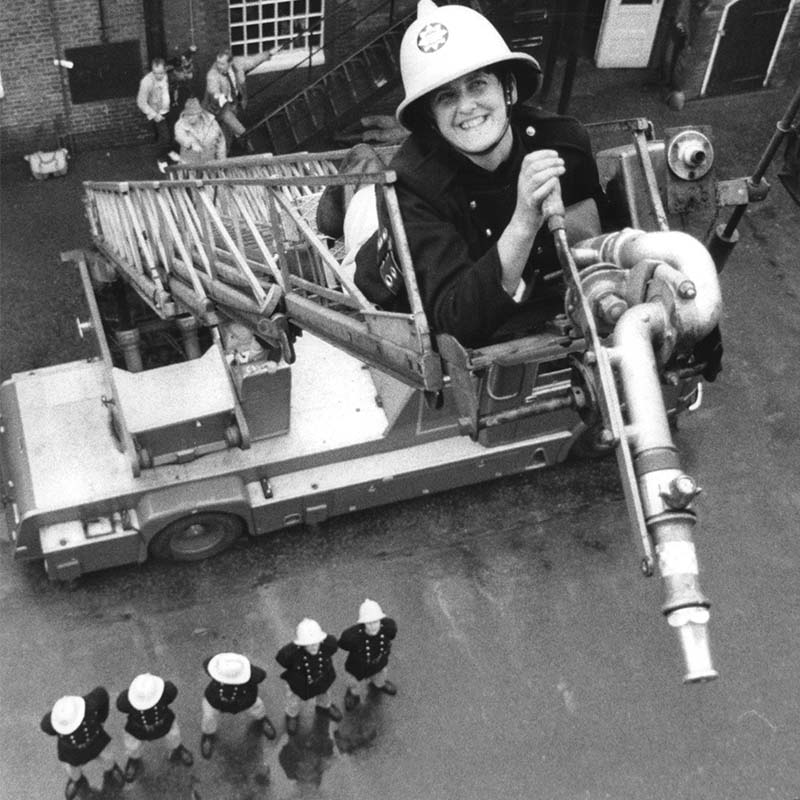
As she marks 40 years since she began her training, London’s first female firefighter Sue Batten has shared her memories of her career for the first time and called for more women to think about a job as a firefighter.
Speaking at a time when just nine per cent of London Fire Brigade’s operational staff are women, Sue spoke of “the extra pressure” of being the first woman to do the role and why firefighting “is not just a job for a man.”
Before she became a firefighter Sue had previously done office work but wanted to do something more active. When she saw an advert in a local newspaper to train as a firefighter, she decided to give it a go.
While she didn't believe that being a woman was a barrier to joining up, she did admit that she read the article a few times over to check it didn’t say that only men could apply. When she initially expressed an interest, she applied using just her first initial.
She then completed a full application form, using all of her details, and after a few months she was invited for an interview.
Her interview and assessment took place at the Brigades’ old Lambeth Headquarters on Albert Embankment. “I remember there was another woman at the interview with me and it was a source of comfort knowing there would be two of us. But when they phoned me afterwards to let me know I had passed they said I was the only woman.
“I remember being a bit disappointed at that. I wasn’t doing it because I wanted to be the first female to do it, I just wanted to be a firefighter. To be the only woman felt like a lot of extra pressure.”
Sue carried out her training at the Brigade’s training centre in Southwark, where she and the rest of her cohort were put through their paces as they learned a range of rescue techniques and familiarised themselves with equipment.
“I remember it sometimes being very odd for me because I would be in the yard doing a training exercise and I would happen to look around briefly and there would be all these other firefighters – who had come to do training on other things – who had come out to the yard to watch. They were watching me because I was woman.
“It wasn’t meant to be antagonistic, they were simply curious, but it obviously was a very odd experience for me.”
She carried out 21 weeks of training – seven weeks longer than the rest of her cohort – before her “pass out” ceremony on September 29 1982 – her 30th birthday.
Her first fire station was Lewisham, where she joined the Blue Watch.
“I think some of them did find it strange having a woman on the watch,” she said. “Some of them didn’t bat an eye lid, but I think maybe a few of them perhaps thought I wasn’t going to last very long.”
Sue was originally issued with standard fit male uniform. “I actually didn’t mind this,” she said: “As women’s clothes didn’t fit me!” She said she later took part in a pilot scheme for women’s uniform.
She also recalled that she was given a control officers cap, rather than a firefighters’ cap as part of her ceremonial ‘undress’ uniform that firefighters wore at formal events. “I didn’t feel comfortable with that,” she said. “I thought it singled me out for being a woman and if I wore it then people would see me as different to the other firefighters.”
Sue later moved to Old Kent Road Fire Station, where she was based for eight years. Similar to a modern day firefighter, she attended a multitude of incidents across London, from fires to people shut In lifts and road traffic accidents. She attended the Bishopsgate bombing in 1993, where she was based in the control unit. in 1993 she moved to Avon Fire and Rescue Service, where she served for 14 years before she retired.
“Being a firefighter is very much a team effort,” she said “You can’t achieve anything unless you work together. I worked with some fantastic people and acquired a range of skills, from first aid and fire safety to driving a fire engine and specialist rescue techniques like rope rescue.
“It’s not a job just for men and it’s not a job just for women. The important thing is that women know that they have the option of joining, if that is something they would like to do.
“If it is something you’re interested in and you think you would be good at it, then go for it.”
The Brigade now employs 425 women in operational roles at various ranks– out of a total of 4, 545 operational staff.
Assistant Commissioner for the London Fire Brigade Jane Philpott said: “It is fantastic to mark 40 years of female firefighting at London Fire Brigade and fascinating to hear the memories of Sue, who paved the way for other female firefighters like myself to join the Brigade.
“Forty years on and the Brigade is a very different place – recruitment, training and uniform are identical for men and women; our fire stations have separate facilities for women and the Brigade also has a women’s support network as part of a range of equality support groups in place.
“The Brigade is committed to increasing the number of female firefighters on its roll and busting myths that firefighting is not a job just for men.
To find out more about becoming a firefighter visit our Become a Firefighter page.